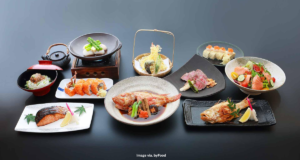
From Chaat to Vada Pav: The Irresistible Delicacies of Indian Street Food
Indian street food has a rich tapestry of diverse flavors, textures and aromas with a vibrant culture. It has its history rooted from centuries of tradition reflecting the rich culture of the country’s culinary heritage and this is the reason why Indian street food holds a special place in everyone’s heart. Popular Indian Street Food Items Ranging from spicy food from the treats of North India to tangail traits from South Indian cuisine every region has its own unique array of street food that will serve taste buds judicially reflecting the rich tapestry of Indian flavors.India’s diverse culinary landscape is perhaps best experienced from its vibrant street food culture. Here are some of the many popular Street foods across various regions of India: North Indian- Chaat When it comes to street food in North India, chaat reigns supreme. There is a diverse range of this tangy and savory street food option in this particular street food which includes bhel puri, pani puri, and aloo tikki chaat. Every spoon of chaat has its own taste full of chutneys, spices, crunchy sev, and fresh herbs, chaat is a culinary adventure that captures the essence of Indian street food. This particular indian street food is over bursting with flavors and spices, also they spin the reason why chaat is the all time favorite street food of Indians. South Indian: Masala Dosa Originating from the southern states of Karnataka and Tamil Nadu, masala dosa is a beloved street food that has gained popularity worldwide. This crispy, golden crepe made from fermented rice and lentil batter is filled with a spiced potato mixture and served with coconut chutney and tangy sambar. This Indian street food is crispy from outside and soft on the inside balancing the entire taste. Originating from South India, dosa is a thin, crispy crepe made from fermented rice and lentil batter. Complementary flavor full chutneys are served along with Dosa, even variations in its filling like a replacement of potatoes with paneer.Eventually serving as the best breakfast and street food option West India: Vada Pav A Mumbai street food icon, vada pav is a humble yet satisfying snack packed with a punch of flavors. A spicy potato fritter is sandwiched between a soft bun and garnished with tangy chutneys, crunchy fried green chilies, and fragrant garlic powder. It’s unic combination with a perfect balance of Spicy make it irresistible. Hailing from the streets of Mumbai. It’s a quintessential grab-and-go snack for Mumbaikars. East India: Puchka In the eastern state of West Bengal, puchka (also known as phuchka or golgappa) is a all time street food across all the regions of India. These crispy, hollow puris are filled with a spicy and tangy mixture of mashed potatoes, chickpeas, tamarind water, and a blend of aromatic spices.A burst of flavors can be enjoyed with each bite of puchka and is an ideal solution for what our taste buds craves for. Also known as golgappa or phuchka, pani puri is a popular street food across India. These crispy hollow puris create a burst of flavors with every bite. Central India: Sabudana Khichdi Central India’s street food scene is perhaps best represented by sabudana khichdi, a wholesome and nutritious snack made from tapioca pearls, peanuts, potatoes, and a medley of spices. This is a light food which provides you with ultimate satisfaction and is often enjoyed during religious festivals and fasting periods, making it a versatile and beloved street food across central India. Kathi Roll Kolkata’s culinary gem, the kathi roll, features a flaky paratha wrapped around a filling of marinated meats, vegetables, or paneer. It’s a convenient and delicious on-the-go meal that satisfies cravings with its spicy and tangy flavors. Samosa and Jalebi A ubiquitous snack found across India, samosas are golden, crispy pastries filled with a savory mixture of potatoes, peas, and spices. Whether enjoyed plain or accompanied by chutneys, samosas are a timeless favorite among street food enthusiasts.On the other hand Jalebi is a sugary delight, and a popular Indian sweet made by deep-frying batter in circular shapes and soaking them in sugar syrup. Crisp on the outside and syrupy on the inside, jalebi is a must-try for those with a sweet tooth. Pav Bhaji Mumbai’s iconic street food dish, pav bhaji is a medley of mashed vegetables cooked with aromatic spices and served with buttered pav (bread rolls). It’s a hearty and flavorsome dish that satisfies hunger pangs and tantalizes taste buds. Street Food Vendors: The Heart of the Culture Indian street food reflects the country’s diverse cultural tapestry, with each region boasting its own unique flavors and culinary traditions. From the fiery spices of North India to the coconut-infused dishes of South India, street food is a celebration of India’s cultural heritage. Street food vendors play a pivotal role in India’s culinary landscape, serving as ambassadors of taste and tradition. These unsung heroes brave the bustling streets day in and day out, dishing out delectable treats that bring joy to millions. Beyond satisfying hunger, street food fosters social connections, bringing people from all walks of life together over a shared love for good food. Whether it’s bonding with friends over chaat or striking up conversations with vendors, street food has a knack for bringing communities closer. Evolution of Street Food in India While traditional recipes remain cherished, street food in India has evolved to embrace modern tastes and trends. From gourmet twists on classic dishes to innovative fusion creations, street food vendors are constantly reinventing themselves to cater to changing palates. While street food is undeniably delicious, concerns about hygiene and sanitation often linger in the minds of consumers. However, initiatives aimed at improving hygiene standards and raising awareness about food safety are gradually addressing these concerns, ensuring that street food remains both delicious and safe to consume. The Future of Indian Street Food As India marches towards progress, the future of street food lies in innovation and sustainability. While preserving cultural authenticity, street food vendors are embracing





